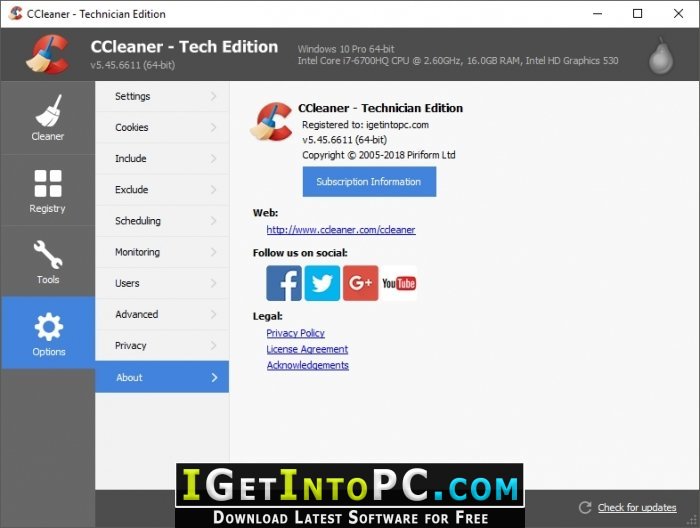

- CCLEANER CLOUD UNINSTALL HOW TO
- CCLEANER CLOUD UNINSTALL INSTALL
- CCLEANER CLOUD UNINSTALL UPDATE
- CCLEANER CLOUD UNINSTALL WINDOWS 10
- CCLEANER CLOUD UNINSTALL SOFTWARE
To make it easier to find a particular app you can sort by names, publisher, install date, and there’s even a search box. Or, you can click the Uninstall button in the right column. Right-click the app you want to uninstall and select Uninstall from the context menu. There you’ll see the universal apps mixed in with your desktop applications.
CCLEANER CLOUD UNINSTALL WINDOWS 10
To remove Windows 10 apps, head to Tools > Uninstall.
CCLEANER CLOUD UNINSTALL UPDATE
If you already have CCleaner installed, just update it by selecting Check for updates in the lower-right corner.
CCLEANER CLOUD UNINSTALL HOW TO
In fact, for more on how to uninstall and manage universal apps in Windows 10, read our article: Install, Uninstall, Update and Manage Windows 10 Apps.īut if you want to remove some of the Windows 10 apps you never use, you can now do that within CCleaner version 5.11. You don’t need CCleaner to uninstall Windows 10 universal apps. If you haven’t upgraded to Windows 10 yet, no worries, it works with Windows 8.1 apps, too. But this update allows you to remove universal apps.
CCLEANER CLOUD UNINSTALL SOFTWARE
It is of little use if you use a single machine on the other hand or want to keep information about your devices and software locked down locally.CCleaner has supported the ability to uninstall desktop applications for quite a while already. It may be useful if you manage multiple computer systems as it provides you with options to control them all from a single location on the Web. The professional version of CCleaner Cloud upgrades the computer limit to 10 and introduces scheduling and 2-factor authentication on top of that.ĬCleaner Cloud offers an impressive set of features that come straight out of popular Piriform applications. Piriform has added Defraggler to CCleaner Cloud on top of that so that you can run defragmentation jobs on local systems from the cloud. A click on run cleaner deletes the data on the target PC. The only option to add custom rules is to add them one by one using the CCleaner settings. One limitation here is that you cannot add new rules using the excellent CCEnhancer application. Some options have been removed there is for instance no startup manager anymore but that is likely because you find it listed under software now in the cloud interface. This includes not only the cleaning options but also other tools such as the Registry Cleaner or Drive Wiper that come with CCleaner. The CCleaner tab lists the same option that you get when you run CCleaner directly on Windows PCs. You find several interesting options listed under Software including options to manage startup items and uninstall software on the selected computer system. Available for selection are popular apps like 7-Zip, Firefox and Notepad++ as well as options to install custom software using Dropbox. There is even an add software option to install custom software directly from the cloud. The information are comprehensive and similar to what Speccy reports when it is run on the PC.

Software on the other hand lists information about the operating system, running processes, startup items and installed software. The core difference between the two is that the first requires input of username and password while the second does not (hand the second to your parents, family members or friends whose computer systems you manage). You may download account-specific or account-independent installers. Once that is out of the way you need to download installers for each computer system that you want to control using CCleaner Cloud. It may take a while before you get the invitation as the system is still invitation-based currently (it took a couple of hours in my case). The first thing you need to do to get CCleaner Cloud working is to create an account on the official site.

Access requires a modern web browser only but no software installation on the control system so that you can control Windows PCs from Linux, Macs or other operating systems as well using CCleaner Cloud. One of the core differences between regular CCleaner versions and CCleaner Cloud is that the control center has been moved to the web so that you can control one or multiple computer systems remotely. For example, locate the cookie in the list and click the right. You’ll probably want to add other cookies to the whitelist, too. CCleaner will automatically add Google, Hotmail, and Yahoo Mail cookies to your whitelist. Piriform, the makers of popular applications such as CCleaner and Recuva have released a cloud-based version of CCleaner recently called CCleaner Cloud. CCleaner can help you with this whitelisting right-click in the Cookies pane and select Intelligent Scan.


 0 kommentar(er)
0 kommentar(er)
